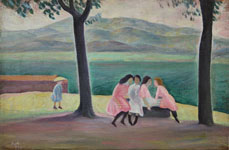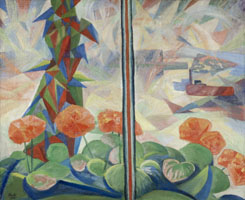 Walter Pach — art historian, critic, art advisor, champion of modern art, organizer of the landmark 1913 Armory Show — was also an artist.
Walter Pach — art historian, critic, art advisor, champion of modern art, organizer of the landmark 1913 Armory Show — was also an artist.
What kind of art did this man, who advised legendary collectors like Walter Arensberg and John Quinn and put Duchamp’s Nude Descending a Staircase on view — make?
On Friday, for the first time in more than 60 years, you’ll be able to see, and it may be a surprise.
Francis Naumann has turned his 57th St. gallery, in New York, over to The Paintings of Walter Pach, in conjunction with the recent publication of Walter Pach (1883-1958): The Armory Show and the Untold Story of Modern Art in America — the first biography  of Pach, published by Penn State Press. It was written by independent scholar and curator Laurette E. McCarthy, who also curated the exhibition and wrote the accompanying catalogue, The Paintings of Walter Pach.
of Pach, published by Penn State Press. It was written by independent scholar and curator Laurette E. McCarthy, who also curated the exhibition and wrote the accompanying catalogue, The Paintings of Walter Pach.
The exhibit, forty-four paintings and watercolors, proceeds chronologically from his student work to work he made in his final years. Here, according to the Naumann website, is how his work evolved:
Pach’s earliest mature works were painted in the bravura style of Impressionism, displaying…the influence of his teachers, William Merritt Chase and Robert Henri. While living and working in Italy in the summers of 1907, 1910 and 1912, Pach heeded the advice of Leo Stein…–who
believed that anyone interested in modern art should explore its sources in the paintings of the Italian Renaissance…In 1912 he deliberately simplified his imagery and heightened his color palette, yet these changes were incidental when compared to those that took place in his work after the Armory Show. For approximately five years, Pach embraced the most advanced manifestations of the new art coming out of Europe–especially Fauvism and Cubism–and painted among the most vibrant and daringly experimental pictures of his career, excelling especially in his use of watercolor. After 1920, he reverted to a figurative style…
Why would this champion of modernism do that? The description says his work retained some aspects of modernism, but still…
The three works I’ve pasted here date from 1912, 1914 and 1922, top to bottom.
So Pach, to me, was no great artist. But it’s hard to fathom what was going on in his head — urging people toward modernism, but taking a step backward in his own work.
Guess we’ll have to read the biography to find out. Or maybe readers have theories.
Photo Credits: Courtesy of Francis M. Naumann Gallery
